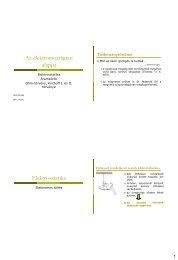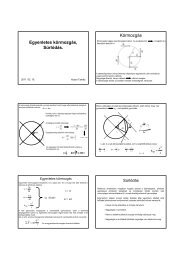Sedimentation, electrophoresis
Sedimentation, electrophoresis
Sedimentation, electrophoresis
Create successful ePaper yourself
Turn your PDF publications into a flip-book with our unique Google optimized e-Paper software.
<strong>Sedimentation</strong>, <strong>electrophoresis</strong><br />
Biophysics lecture<br />
Talián Csaba Gábor<br />
21. 03.2012.
sedimentation = settling<br />
Sedeo 2, sedi, sessum – sit<br />
Aim:<br />
1 - separation<br />
2 - measure the size or mass of the<br />
particles
F upthrust = ρ mVg<br />
ρρ km<br />
<br />
<br />
<br />
m, ρ<br />
v<br />
<br />
<br />
F g= mg<br />
<strong>Sedimentation</strong> in a gravity field<br />
F frict= fv<br />
<br />
<br />
<br />
<br />
F = F +<br />
g<br />
upthrust<br />
F<br />
frict<br />
ρVg<br />
− ρm<br />
Vg =<br />
spherical<br />
particle<br />
to calculate<br />
v<br />
to measure<br />
V = 4<br />
sed<br />
fv<br />
F − F =<br />
g<br />
upthrust<br />
F<br />
frict<br />
v = constant<br />
3 r3π Ffrict = 6πη0rv<br />
=<br />
(η 0: viscosity of the medium)<br />
2r<br />
ρ m: density of the medium; m: mass, ρ: density, v: velocity of the moving spherical particle<br />
2<br />
( − ρ )<br />
ρ m g<br />
9η<br />
0
<strong>Sedimentation</strong> in a centrifugal field:<br />
1. <strong>Sedimentation</strong> velocity method<br />
Aim: measurement of molecular mass (r ≈ nm)<br />
methods based on gravity are not effective<br />
How to calculate the forces?<br />
F frict =<br />
fv<br />
F centrifug =<br />
2<br />
mrω<br />
2<br />
ρ ρ rω<br />
ρ<br />
m<br />
mVa<br />
=<br />
Fupthrust =<br />
m<br />
Spinning system: a = rω2
What is centrifugal force?<br />
No acceleration Acceleration<br />
F cf = -mrω 2
F frict =<br />
fv<br />
Fcentrifug =<br />
2<br />
mrω<br />
Fupthrust m =<br />
2 m 2<br />
2⎛<br />
ρm<br />
⎞<br />
fv = mrω<br />
− ρm<br />
rω<br />
= mrω<br />
⎜1−<br />
⎟<br />
ρ<br />
⎝ ρ ⎠<br />
but<br />
a = rω 2<br />
2<br />
ρ rω<br />
ρ<br />
m<br />
Upon sedimentation the velocity of the particle<br />
increases while going further from axis! (v ≠ constant)
Theodore Svedberg<br />
Swedish chemist<br />
(1884-1971)<br />
Nobel-prize in 1926<br />
S<br />
=<br />
v<br />
2<br />
rω<br />
to measure<br />
⎛ ρk<br />
⎞<br />
m⎜1−<br />
⎟<br />
=<br />
⎝ ρ ⎠<br />
f<br />
to calculate<br />
S = sedimentation constant<br />
Unit: 1 Sv = 10 -13 s<br />
<strong>Sedimentation</strong><br />
velocity for unit<br />
acceleration<br />
shape factor!<br />
Relationship between shape factor (f) and diffusion constant (D):<br />
k ⋅T<br />
D<br />
R ⋅T<br />
N D<br />
To determine the mass sedimentation<br />
methods must be combined with<br />
diffusion measurements.<br />
f<br />
=<br />
=<br />
A ⋅<br />
kkkk:::: Boltzmann constant<br />
R: R: R: R: universal gas constant<br />
NNNN : Avogadro-number.<br />
=<br />
∙ ∙ <br />
∙ ∙ ( − <br />
)
Normal centrifuge<br />
Centrifuge<br />
Supercentrifuge: 20-50.000 rpm (revolution per minute)<br />
Ultracentrifuge: over 50.000 rpm<br />
Analytical centrifuge: determination of size and mass of molecules<br />
Preparative centrifuge: separation of molecules based on their mass and size<br />
angle rotor<br />
swing-out rotor
Velocity boundary sedimentation method<br />
A: boundary<br />
B: plateau<br />
: concentration profile without diffusion
2. <strong>Sedimentation</strong> equilibrium method<br />
low speed centrifugation<br />
diffusion<br />
Jean Baptiste Perrin<br />
French physicist<br />
(1870-1942)<br />
Nobel-prize in 1926<br />
sedimentation
Energy<br />
energia<br />
E 2<br />
E 1<br />
to calculate<br />
c 2<br />
c 1<br />
c<br />
c<br />
c<br />
1<br />
2<br />
=<br />
e<br />
E −E<br />
1 −<br />
kT<br />
m ⎛ ρ ⎞<br />
ω ⎜ − ⎟<br />
2 ⎝ ρ ⎠<br />
2<br />
( ) 2 2<br />
r r<br />
2 m E1 − E2<br />
= 1<br />
2 −<br />
2⎛<br />
ρm<br />
⎞<br />
mω<br />
⎜1−<br />
⎟<br />
⎝ ρ ⎠<br />
( ) 2 2<br />
r −<br />
2 ln =<br />
2 r1<br />
c1<br />
2kT<br />
to measure<br />
No influence of the molecular shape!<br />
1
Advantages of the analytical ultracentrifugation<br />
No standards are required<br />
AUC is sensitive, precise, accurate and robust (yes – all at a time!)<br />
No interactions with a stationary phase or matrix<br />
Wide range of molar masses can be investigated in the same<br />
experiment – works well for peptides to viruses.<br />
No protein modifications required<br />
No change in mobile phase – your protein is examined in exactly the<br />
same solvent in which you want to study it<br />
Theory of sedimentation is well understood
F centrifug =<br />
3. Density gradient method<br />
2<br />
mrω<br />
Fupthrust m =<br />
2<br />
ρ rω<br />
ρ<br />
m<br />
If ρ = ρ m then F c = mrω 2 = F up and v = 0!<br />
High molecular mass, small size:<br />
CsCl, CsBr, glycerol, sucrose (saccharose), ficoll<br />
Blood lipoproteins
Differential centrifugation/<br />
cellular fractionation<br />
Albert Claude<br />
Belgian biologist<br />
(1899-1983)<br />
Nobel-prize in 1974<br />
mitochondria microsomes lysosomes
Electrophoresis<br />
Ionic double layer<br />
Arne Tiselius<br />
Swedish biochemist<br />
(1902-1971)<br />
Nobel-prize in 1948
Coulomb-force: Friction force:<br />
F c = QE = ZeE<br />
E= electric field strength<br />
e = elementary charge<br />
Z= charge number<br />
Till when is the particle accelerating?<br />
F F = : until ZeE = fv<br />
c<br />
u el = v<br />
E<br />
up<br />
electrophoretic mobility<br />
= Ze<br />
f<br />
Ze<br />
6πηr<br />
F f = fv<br />
v = velocity<br />
f = shape factor<br />
For spherical molecules:<br />
ZeE = 6πηrv<br />
(Stokes-law)<br />
= Radius of molecule is<br />
to be calculated
Agarose gel <strong>electrophoresis</strong>
SYBR green
SDS polyacrylamide gel <strong>electrophoresis</strong> (SDS-PAGE)<br />
sodium-dodecyl-sulphate<br />
TEMED (tetramethylethylenediamine)<br />
ammonium-persulphate
Coomassie Brillant Blue<br />
+ protein
Native PAGE
Isoelectric focusing (IEF)
2D <strong>electrophoresis</strong>
pH pH pH 33<br />
3 3<br />
pH pH 10<br />
10<br />
biotech.szbk.u-szeged.hu/KK_Jegyzet/.../5_Downstream_1.ppt
iotech.szbk.u-szeged.hu/KK_Jegyzet/.../5_Downstream_1.ppt
THANK YOU FOR YOUR<br />
ATTENTION!


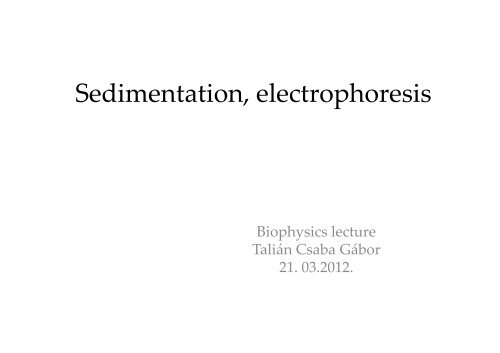
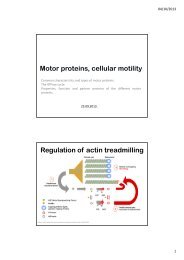
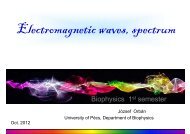
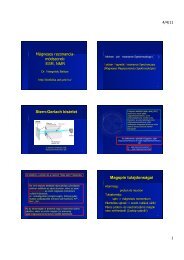
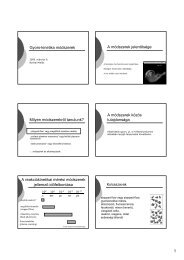
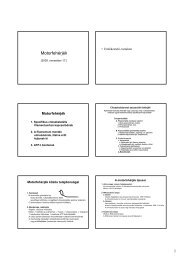

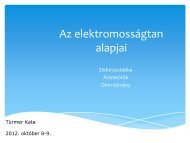
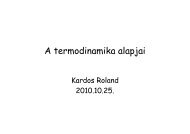


![Microsoft PowerPoint - Intermedier filamentumok [Kompatibilis m\363d]](https://img.yumpu.com/17119137/1/190x135/microsoft-powerpoint-intermedier-filamentumok-kompatibilis-m363d.jpg?quality=85)
